Digital Poster
Thermometry
ISMRM & ISMRT Annual Meeting & Exhibition • 03-08 June 2023 • Toronto, ON, Canada

| Computer # | |||
|---|---|---|---|
 |
4987.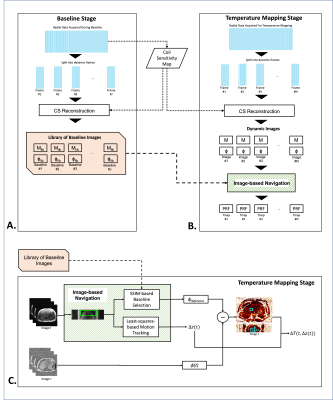 |
41 |
Dynamic 3D Stack-of-Radial Multi-Baseline PRF MR Thermometry
using Compressed Sensing Reconstruction and Image-Based
Navigation
Qing Dai1,2,
Shu-Fu Shih1,2,
Jiaqi Zhou3,
Le Zhang1,
and Holden H Wu1,2
1Radiological Sciences, University of California, Los Angeles, Los Angeles, CA, United States, 2Bioengineering, University of California, Los Angeles, Los Angeles, CA, United States, 3Department of Engineering Physics, Tsinghua University, Beijing, China Keywords: Thermometry, Motion Correction, Multi-baseline Thermometry Multi-baseline proton resonance frequency-shift (PRF) MR thermometry can reduce motion-induced temperature errors in moving organs during MR-guided thermal therapy. However, previous methods had to compromise the spatial coverage to increase the temporal resolution for resolving motion. This work developed a dynamic 3D stack-of-radial MRI method using compressed sensing reconstruction and image-based navigation to enable motion-resolved multi-baseline PRF thermometry with 1.4-sec true temporal resolution. The proposed method achieved stable thermometry with volumetric coverage in free-breathing liver MRI without heating. |
4988.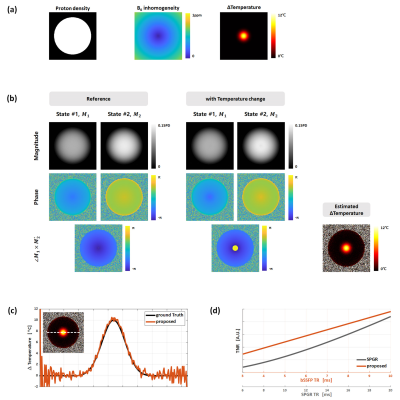 |
42 |
A dual-flip angle bSSFP imaging method for proton resonance
frequency-based thermometry
Seohee So1,
HyunWook Park2,
and Hyunseok Seo1
1Korea Institute of Science and Technology, Seoul, Korea, Republic of, 2Korea Advanced Institute of Science and Technology, Daejeon, Korea, Republic of Keywords: Thermometry, Thermometry Proton resonance frequency thermometry estimates temperature change by detecting the frequency change which is proportional to that of the temperature. In this study, we propose a dual- flip angle bSSFP thermometry method that generates a high intensity signal and linear phase to the frequency shift. Two steady states of the proposed method have phase dependency on the off-resonance frequency and the phase difference between the steady states has a linear relation with the off-resonance frequency. The linear phase relation makes it possible to measure temperature change. And the acquired high intensity signal benefits temperature monitoring and guidance for thermal therapy. |
|
4989.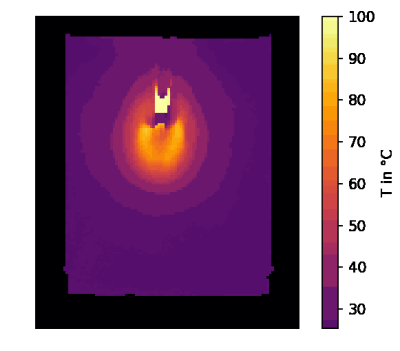 |
43 |
Applicability of Magnetic Resonance Fingerprinting for Proton
Resonance Frequency Shift based Temperature Monitoring of
Microwave Ablation
Moritz Gutt1,
Josef Joaquin Löning Caballero2,
Dominik Horstmann2,
Frank Wacker2,
Bennet Hensen2,
and Marcel Gutberlet2
1Computational Health Informatics, Leibniz University Hannover, Hannover, Germany, 2Diagnostic and Interventional Radiology, Hannover Medical School, Hannover, Germany Keywords: Thermometry, MR Fingerprinting MRI offers the unique ability of measuring the temperature inside of the patient during minimally invasive tumor ablation. In this proof-of-concept approach MR Fingerprinting was used in order to get an accurate thermometry with potential for real-time application. The method was validated by performing a microwave ablation in a bioprotein phantom. The temperature accuracy was 1.54 °C ± 0.85 °C and the dice score between the calculated and the ground truth denaturation zone was 90.02 %. The mean standard deviation of the non-heated area was 0.19 °C. |
|
4990.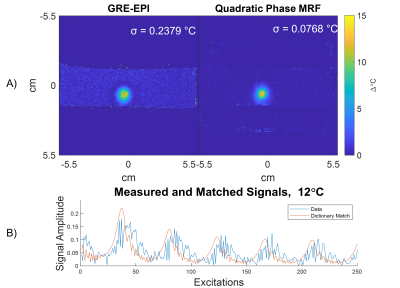 |
44 |
MR Thermometry by Quadratic Phase MR Fingerprinting
Sarah J Garrow1,
John Peters1,
Abby Grillo1,
Rasim Boyacioglu2,
Kathryn E Keenan3,
Mark A Griswold2,
and William A Grissom1
1Vanderbilt University, Nashville, TN, United States, 2Case Western Reserve University, Cleveland, OH, United States, 3National Institute of Standards and Technology, Boulder, CO, United States Keywords: Thermometry, MR-Guided Interventions PRF-shift thermometry is the current standard for MR-based temperature monitoring in interventional procedures and works by converting gradient-recalled image phase changes to temperature changes. However, the long TE required for phase contrast increases sensitivity to artifacts from motion. We propose to address this using quadratic phase MR fingerprinting (qRF-MRF) which is robust to spurious artifacts. We implemented a qRF-MRF sequence that sweeps continuously across resonance frequencies and is highly sensitive to heating-induced resonance frequency changes. The sequence was used to monitor laser heating in a phantom, with comparison to GRE thermometry. |
|
4991. |
45 |
Sparse regression-based delineation of air-motion artifacts for
real-time correction of PRFS thermometry
Sven Nouwens1,
Maarten Paulides2,3,
and Maurice Heemels1
1Mechanical Engineering, Eindhoven University of Technology, Eindhoven, Netherlands, 2Electrical Engineering, Eindhoven University of Technology, Eindhoven, Netherlands, 3Radiotherapy, Erasmus MC, Rotterdam, Netherlands Keywords: Sparse & Low-Rank Models, Thermometry, susceptiblity aritfact correction Proton resonance frequency shift-based MR thermometry is widely used to non-invasively monitor thermal therapies in vivo. However, further clinical integration in deep hyperthermia is hampered by intestinal air-motion induced susceptibility artifacts. We developed a sparse regression approach to delineate susceptibility artifact sources. The resulting mask is then used to correct the artifact using existing methods from quantative susceptibility mapping. We verified our approach by a heated phantom experiment equipped with a moveable air volume and temperature probes. Here, we found a reduction in the mean absolute error from 1.6 degrees Celsius to 0.4 degrees Celsius, near the air-motion artifact. |
|
4992.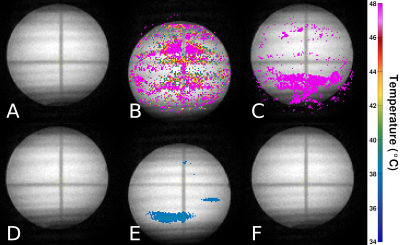 |
46 |
Compensation for Sporadic Motion in MR Thermometry Though a
Hybrid Augmented Multi-Baseline and Near-Referenceless Approach
Arthur Akbulatov1,
Suzanne M Wong1,2,
Craig A Macsemchuk1,2,
Andrew Headrick1,
James M Drake1,2,
and Adam C Waspe1,3
1Posluns Centre for Image Guided Innovation & Therapeutic Intervention, The Hospital for Sick Children, Toronto, ON, Canada, 2Institute of Biomedical Engineering, University of Toronto, Toronto, ON, Canada, 3Department of Medical Imaging, University of Toronto, Toronto, ON, Canada Keywords: Motion Correction, Motion Correction Magnetic resonance-guided high-intensity focused ultrasound (MRgHIFU) treatments are limited by motion artifacts introduced into MR thermometry calculations by large sporadic motions. A hybrid principal component analysis and projection onto dipole fields (PCA-PDF) motion compensation algorithm was expanded upon to include predicted motion using image augmentation techniques. When tested on MR images from a gelatin phantom being translated in the coronal plane, the improved PCA-PDF algorithm yielded a temperature standard deviation of 0.4 ± 0.1 °C, which is a 3.7 ± 0.1 °C reduction from an unmodified PCA-PDF approach, indicating that thermometry artifacts induced by motion were significantly reduced. |
|
4993.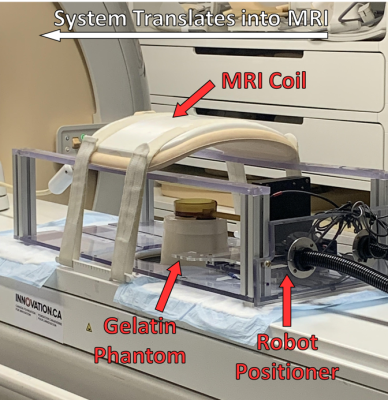 |
47 |
Validation of an MR Thermometry Motion Compensation Algorithm
for Periodic Motion During MR guided High Intensity Focused
Ultrasound (MRgHIFU)
Suzanne M Wong1,2,
Craig A Macsemchuk1,2,
Andrew Headrick1,
Phoebe Luo1,
Arthur Akbulatov1,
James M Drake1,2,
and Adam C Waspe1,3
1Posluns Centre for Image Guided Innovation & Therapeutic Interventions, Hospital for Sick Children, Toronto, ON, Canada, 2Department of Biomedical Engineering, University of Toronto, Toronto, ON, Canada, 3Department of Medical Imaging, University of Toronto, Toronto, ON, Canada Keywords: Motion Correction, Thermometry Magnetic resonance-guided high-intensity focused ultrasound (MRgHIFU) can noninvasively administer controlled hyperthermia as an adjuvant cancer therapy. For clinical translation, one of the main challenges is the sensitivity of MR thermometry to motion artifacts. This work aims to validate a real-time hybrid principal component analysis and projection onto dipole fields (PCA-PDF) motion compensation algorithm on a clinical MRgHIFU system during reproducible motion profiles. The real-time PCA-PDF algorithm maintained a temperature standard deviation of < 1°C in a phantom while the periodic motion was induced on a phantom using an MR-compatible robot. |
|
| 4994. | 48 |
Deep Learning based drift field correction for MR Thermometry in
the upper leg at 7T
E.F. Meliadò1,2,3,
M.W.I. Kikken1,
B.R. Steensma1,2,
C.A.T van den Berg2,4,
and A.J.E. Raaijmakers1,2,5
1Department of Radiology, University Medical Center Utrecht, Utrecht, Netherlands, 2Computational Imaging Group for MR diagnostics & therapy, Center for Image Sciences, University Medical Center Utrecht, Utrecht, Netherlands, 3Tesla Dynamic Coils BV, Zaltbommel, Netherlands, 4Department of Radiotherapy, University Medical Center Utrecht, Utrecht, Netherlands, 5Biomedical Image Analysis, Dept. Biomedical Engineering, Eindhoven University of Technology, Eindhoven, Netherlands Keywords: Safety, Thermometry PRFS-based MR Thermometry (MRT) bears strong potential for RF safety assessment. However, PRFS-MRT is impaired by external sources of frequency shift. It is hypothesized that deep learning will be able to separate the PRFS signal from these other sources of frequency shift. This study has tested this concept on drift field correction for MRT in the human thigh at 7T. A convolutional neural network is trained using synthetic phase difference images based on measured drift fields and simulated temperature distributions. Results show that the proposed deep-learning approach is able to correctly predict both simulated and measured temperature rise distributions. |
|
4995. |
49 |
Evaluating Various Phase Drift Correction Methods in PRFS-based
Thermometry in the Pelvic Region of Free-Breathing Volunteers
Othmar Belker1,2,
Bennet Hensen1,2,
Frank Wacker1,2,
and Marcel Gutberlet1,2
1Institute for Diagnostic and Interventional Radiology, Hannover Medical School, Hannover, Germany, 2STIMULATE-Solution Centre for Image Guided Local Therapies, Magdeburg, Germany Keywords: System Imperfections: Measurement & Correction, Thermometry, Proton Resonance Frequency Shift, Phase Drift Proton Resonance Frequency Shift Thermometry relies on a homogeneous B0-field as the B0-field significantly influences the resonance frequency. A multitude of phase drift correction methods have been proposed. The temperature accuracy and computing time of reference-less phase estimation, prospective, and fat-based phase correction have been evaluated in a manually segmented dorsal muscle ROI in the pelvic region of free-breathing volunteers. The evaluated phase drift correction methods correct phase drift comparably regarding temperature accuracy. Fat-based and prospective phase correction are almost ten times faster than reference-less phase estimation but require a reliable baseline acquisition. |
|
4996.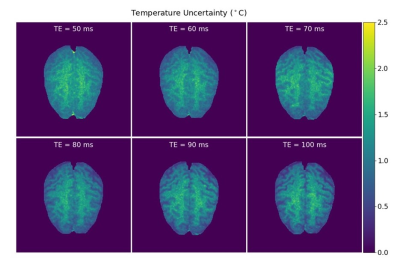 |
50 |
Optimization of EPI based PRF thermometry at 0.5 T
Chad T Harris1,
Curtis N Wiens1,
Diego F Martinez2,
Andrew T Curtis1,
and Blaine A Chronik2
1Research and Development, Synaptive Medical, Toronto, ON, Canada, 2The xMR Labs, Department of Physics and Astronomy, Western University, London, ON, Canada Keywords: Data Acquisition, Thermometry Echo planar imaging (EPI) is well-suited for temperature mapping in the mid-field (0.5T) thanks to longer T2* values that can be leveraged without prohibitively slow update rates. In this work, we optimize EPI based PRF thermometry acquisitions for mid-field MRI. Digital simulations and in-vivo temperature stabilities were computed over echo times ranging from 50ms – 100ms. The optimal mean temperature uncertainty over the entire acquisition volume was measured to be approximately 1⁰C demonstrating that EPI based thermometry provides clinically viable sensitivity at 0.5T with sufficient image resolution and extremely fast update rates (1.3-2 s). |
|
4997.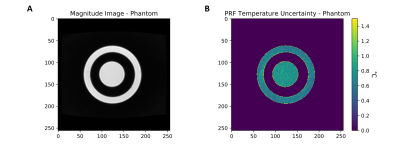 |
51 |
Monitoring Temperature using Gradient Echo Imaging at 0.5T
Diego F Martinez1,
Chad T. Harris2,
Curtis N. Wiens2,
Will B. Handler1,
and Blaine A. Chronik1,3
1The xMR Labs, Physics and Astronomy, Western University, London, ON, Canada, 2Research and Development, Synaptive Medical, Toronto, ON, Canada, 3Medical BioPhysics, Western University, London, ON, Canada Keywords: Thermometry, Phantoms Gradient Echo Proton Resonant Frequency (GRE-PRF) based thermometry, a standard approach to temperature mapping, was assessed at 0.5T. Experiments were performed using a 3 slice GRE acquisition at a resolution of 2x2x5mm and an update rate of 7.7s. Phantom and in-vivo measurements of the temperature stability yielded uncertainties of 0.78°C and 1.48°C respectively. Furthermore, a cooling experiment with the phantom showed excellent agreement to temperature changes simultaneously measured with a temperature probe. All results suggest that GRE-PRF thermometry is feasible at 0.5T. |
|
4998.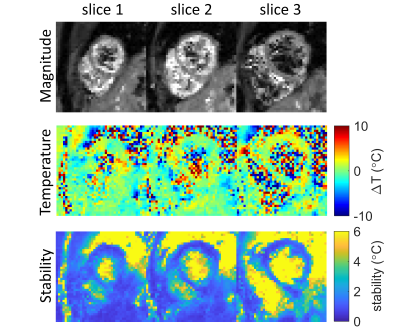 |
52 |
Low field cardiac MR thermometry: feasibility at 0.55T
Ronald Mooiweer1,2,
Charlotte Rogers1,
Radhouene Neji1,2,
Reza Razavi1,
and Sébastien Roujol1
1School of Biomedical Engineering and Imaging Sciences, Faculty of Life Sciences and Medicine, King's College London, London, United Kingdom, 2MR Research Collaborations, Siemens Healthcare Limited, Camberley, United Kingdom Keywords: Myocardium, Thermometry Low field strength MRI scanners are appealing for MR guided interventions because of their lower associated costs and increased compatibility with interventional devices. Cardiac PRFS thermometry shows promise for real-time guidance of ablation therapy of cardiac arrhythmias. In this study, initial characterization of cardiac PRFS thermometry at 0.55T was performed in 5 healthy volunteers by measuring the stability over time. The stability of thermometry was 1.6±0.8 °C in the myocardium, confirming feasibility at this field strength. |
|
4999.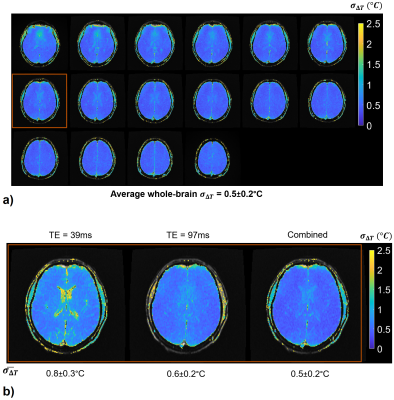 |
53 |
PRF thermometry at 0.55T using multi-contrast segmented EPI
approach
Waqas Majeed1,
Henrik Odéen2,
Dennis L. Parker2,
Florian Maier3,
Jianing Pang1,
and Axel J. Krafft3
1Siemens Medical Solutions USA Inc., Malvern, PA, United States, 2Department of Radiology and Imaging Sciences, University of Utah, Salt Lake City, UT, United States, 3Siemens Healthcare GmbH, Erlangen, Germany Keywords: Thermometry, Multi-Contrast, Prostate, Brain MR thermometry based on the proton resonance frequency (PRF) shift is a widely used tool to monitor changes in tissue temperature in response to MR-guided thermal interventions. However, MR temperature mapping at low field (< 1T) is challenging because of reduced signal to noise ratio (SNR) and intrinsically low temperature-sensitivity of the PRF shift. In this work, we present a multi-contrast segmented EPI sequence for PRF thermometry at low field. The proposed sequence provides high sampling efficiency and improves temperature quantification via echo combination. The performance of the sequence was tested in healthy volunteer measurements in the absence of heating. |
|
5000. |
54 |
Susceptibility artifacts during MR-guided laser interstitial
thermal therapy: characterization and temperature-based control
solutions
De Landro Martina1,
Céline Giraudeau2,
Juan Verde2,
Khalid Ambarki3,
Sanzhar Korganbayev1,
Henrik Odeen4,
Benoît Gallix2,
and Paola Saccomandi1
1Politecnico di Milano, Milan, Italy, 2IHU Strasbourg, Institute of image-guided surgery, Strasbourg, France, 3Siemens Healthcare SAS, Saint Denis, France, 4University of Utah, Salt Lake City, UT, United States Keywords: Interventional Devices, MR-Guided Interventions The use of Magnetic Resonance Thermometry (MRT) has been proposed to intraoperatively guide laser interstitial thermal therapy (LITT) thanks to its ability to provide multidimensional temperature measurements. PRF-based MRT thermometry holds significant benefits, but it is still limited by susceptibility artifacts that significantly affect the accuracy of measured temperature maps. These artifacts lead to a negative temperature distribution with a double-lobe shape around the laser applicator. In this work, artifacts appearing in MRT images during LITT and linked to magnetic field distortion related to susceptibility variations are characterized in ex-vivo livers. We further propose an approach to avoid their appearance. |
|
5001.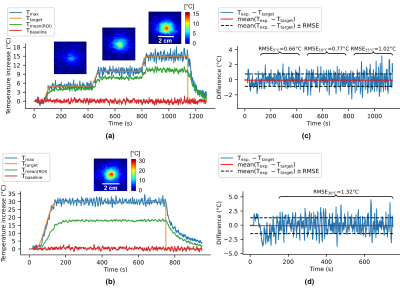 |
55 |
Real-time automatic temperature regulation during in-vivo
MRI-guided Laser-induced Thermo-Therapy (MR-LITT)
Manon Desclides1,2,
Valéry Ozenne1,
Pierre Bour2,
Thibault Faller2,
Guillaume Machinet3,
Christophe Pierre3,
Stéphane Chemouny2,
and Bruno Quesson1
1University of Bordeaux, CNRS, CRMSB, UMR 5536, IHU Liryc, Bordeaux, France, Metropolitan, 2Certis Therapeutics, Pessac, France, 3ALPhANOV, Talence, France Keywords: Interventional Devices, MR-Guided Interventions The presented method allows to automatically adjust laser power relying on real-time rapid volumetric MR-thermometry using the proton resonance frequency (PRF) shift technique. The laser output power is regulated every second to force temperature to follow a predefined temperature-time profile using a PID controller, taking MR-temperature data as input. The proposed temperature regulation algorithm is successfully validated in vivo in the skeletal muscle of a pig. |
|
5002.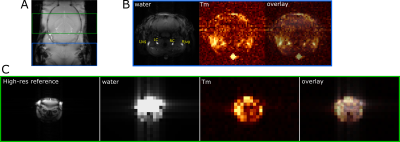 |
56 |
Minimally invasive measurement of arterial and brain temperature
in the mouse
Lisa M Gazdzinski1,
Luke Chung1,2,
Shoshana Spring1,
Owen Botelho1,
Bojana Stefanovic2,3,
Brian J Nieman1,2,4,
Chinthaka C Heyn3,5,
and John G Sled1,2
1Mouse Imaging Centre, Hospital for Sick Children, Toronto, ON, Canada, 2Medical Biophysics, University of Toronto, Toronto, ON, Canada, 3Physical Sciences, Sunnybrook Research Institute, Toronto, ON, Canada, 4Ontario Institute for Cancer Research, Toronto, ON, Canada, 5Medical Imaging, University of Toronto, Toronto, ON, Canada Keywords: Thermometry, Metabolism, lanthanide, mice, brain Brain temperature is an important physiological parameter that both reflects and modulates brain activity, but current in vivo thermometry methods are invasive and/or impractical for small animals. We present a minimally invasive method for measuring blood and brain temperature in mice using Tm-DOTMA and characterize the relationship between brain and blood temperature under isoflurane anesthesia. Brain temperature was strongly correlated and approximately equal to the temperature of the inflowing arterial blood, possibly reflecting the vasodilatory and metabolic suppressive effects of isoflurane. Application of this method with alternative anesthesia approaches would provide insight into brain temperature regulation in health and disease. |
|
5003.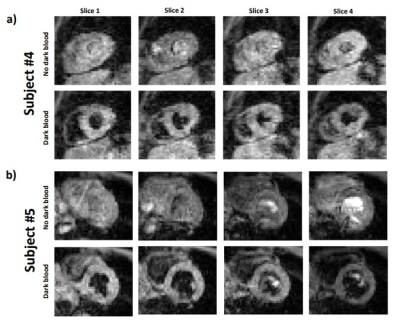 |
57 |
Feasibility of fast single-phase volumetric cardiac
MR-thermometry
Charlotte Rogers1,
Ronald Mooiweer1,2,
Grzegorz Kowalik1,
Radhouene Neji1,2,
Reza Razavi1,
Rene Botnar1,3,4,
and Sebastien Roujol1
1School of Biomedical Engineering and Imaging Sciences, Faculty of Life Sciences and Medicine, King's College London, London, United Kingdom, 2MR Research Collaborations, Siemens Healthcare Limited, Camberley, United Kingdom, 3School of Engineering, Pontificia Universidad Católica de Chile, Santiago, Chile, 4Institute for Biological and Medical Engineering, Pontificia Universidad Católica de Chile, Santiago, Chile Keywords: Myocardium, Thermometry A novel fast simultaneous multi-slice black blood cardiac thermometry sequence is presented which allows multiple slices to be acquired in the same cardiac phase. A double inversion recovery pre-pulse is introduced to allow blood suppression and to optimise the pre-pulse strategy and therefore reduce acquisition time. Simultaneous multi-slice (SMS) imaging is integrated to further reduce the acquisition time of the multiple slices. Thermometry results obtained with this technique show an average temperature stability of 1.0±0.4°C in healthy subjects. |
|
5004.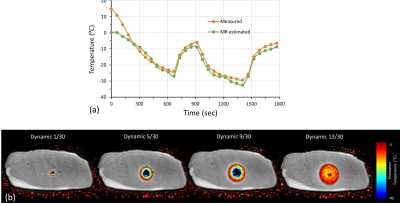 |
58 |
Thermometry of frozen tissue during cryoablation at 1.5T with a
novel 3D spiral staircase UTE sequence (SSCUTE) – A feasibility
study
Guruprasad Krishnamoorthy1,2,
Jacinta Browne2,
Aiming Lu2,
David A. Woodrum2,
and James G. Pipe2
1MR R&D, Philips Healthcare, Rochester, MN, United States, 2Department of Radiology, Mayo Clinic College of Medicine and Science, Rochester, MN, United States Keywords: New Trajectories & Spatial Encoding Methods, Thermometry This study assessed the feasibility of thermometry of frozen tissue during MRI-guided cryoablation at 1.5T using a novel 3D spiral staircase UTE sequence (SSCUTE). MRI data using the SSCUTE sequence were continuously acquired along with temperature measurements during several freeze-thaw cycles in ex-vivo porcine specimens. A calibration curve was obtained using temperature measurements and corresponding MRI data. MRI-estimated temperature maps were generated with high accuracy using the calibration curve on a validation dataset. Our work demonstrated the feasibility of thermometry of frozen tissue using SSCUTE sequence at 1.5T, which could be an essential step in clinical adoption of this technique. |
|
5005.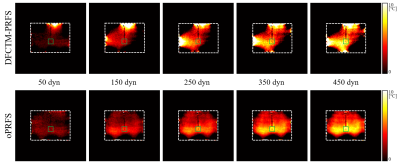 |
59 |
A New-found Approach to Temperature Monitoring Utilizing a
Magnetic Field Map
Sangwoo Kim1 and
Sukhoon Oh2
1Daewon University College, Jecheon-si, Korea, Republic of, 2Korea Basic Science Institution, Ochang-eub, Korea, Republic of Keywords: Safety, Thermometry We showed a new approach of MR temperature mapping without the oil-based phase reference of the conventional proton resonance frequency shift method (cPRFS), named as delta field-corrected temperature mapping (DFCTM). The performance of the DFCTM was compared with measurements using fiber optic thermal sensor and the cPRFS at the human-tissue mimicking agar-gel phantom. The sensor–measured temperature range was 6.05 ℃, while the DFCTM exhibited about 5.93 ℃. It exhibited a difference of -0.12 ℃ and the RMSE of the DFCTM was 0.16 ℃ for the entire experiments, which means that it could realize a temperature monitoring without oil phantoms. |
|
5006.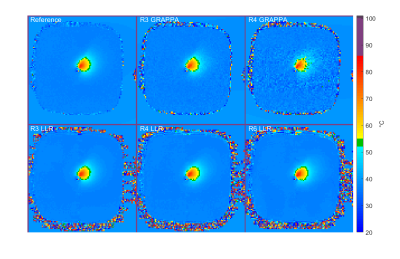 |
60 |
Accelerated MRI thermometry guidance for transurethral
ultrasound ablation of the prostate using locally low rank
reconstruction
Ben YC Leung1,
Robert M. Staruch1,
and Mark Chiew2,3
1Profound Medical, Mississauga, ON, Canada, 2Medical Biophysics, University of Toronto, Toronto, ON, Canada, 3Physical Sciences, Sunnybrook Research Institute, Toronto, ON, Canada Keywords: Thermometry, Interventional Devices, TULSA MRI-guided transurethral ultrasound ablation of the prostate (TULSA) is controlled based on dynamic proton resonance frequency shift MR temperature imaging. Given the localized, but spatio-temporally coherent heating pattern, locally low rank (LLR) reconstruction could facilitate accelerated thermometry. Images acquired during TULSA in a phantom were retrospectively under-sampled by acceleration factors of R=3,4,6 by randomly sub-sampling EPI segments, and reconstructed using LLR constraints with non-overlapping 4D patches and cycle-spinning patch shifts. LLR reconstruction demonstrated lower variance than GRAPPA reconstructions in unheated regions, but increasing measurement bias at R≥4. In vivo investigation of LLR reconstruction of MR thermometry for TULSA is warranted. |
|
The International Society for Magnetic Resonance in Medicine is accredited by the Accreditation Council for Continuing Medical Education to provide continuing medical education for physicians.